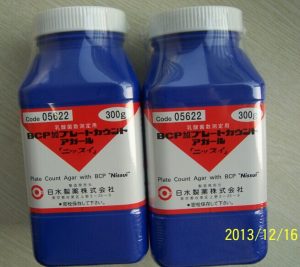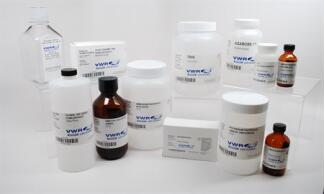NISSUI 日本日水培养基 Viable bacteria


NISSUI 日本日水培养基 Viable bacteria

NISSUI 日本日水培养基 06742 Compact Dry “Nissui” EC

Amresco 0172-250G BIS-ACRYLAMIDE 甲叉双丙烯酰胺
日本和光纯药试剂(wako) N/400聚乙烯硫酸钾 500ml/瓶 聚乙烯硫酸钾(原装)是WAKO产品之一,WAKO(和光纯药)是世界五大实验室化学试剂供应商之一
164-21655-聚乙烯硫酸钾(PVSK)滴定液(N /400)日本和光Wako进口
日本和光Wako 164-21655 聚乙烯硫酸钾(PVSK)滴定液(N /400)
聚乙烯硫酸钾(PVSK)
CAS号:26837-42-3
产地:日本和光纯药 WAKO
包装:500ML/瓶
【用途】聚乙烯硫酸钾Potassium Polyvinyl Sulfate(PVSK)是一种简单、快速、准确的测定高分子聚合物的阴离子胶质滴定用液。利用直接滴定,进行阳离子高分子化合物的定量。于水中可形成带负电的胶体颗粒,甲基乙二醇壳聚糖滴定液-Methyl Glycol Chitosan(MGC)在酸性水溶液中带正电,利用电性中和的原理,负电胶体颗粒的会与正电胶体颗粒反应达到电性中和,在适当的pH条件下,此两种胶体可完全反应形成不溶性沉淀物,使用甲苯胺蓝Toluidine Blue(TB)为指示剂,与正电性胶体混合时,两者之间没有反应,TB维持蓝色;当悬浮液中胶体带负电时,TB会吸附于胶体表面而现紫色,滴定时,正电胶体可直接以PVSK溶液为滴定液,TB为指示剂进行滴定;对于负电荷胶体,可以直接以MGC滴定,或加入已知的过量的正电胶体,再以PVSK溶液对剩余的正电胶体进行反滴定。阳离子或碱性高分子的定量(容量分析)。
Wako和光纯药:Wetting Tension Test Mixture 表面湿润张力测试液,表面张力测试液
日本进口 WAKO 表面张力测试液 50ML
上海金牌生物科技有限公司提供Wako和光纯药:Wetting Tension Test Mixture 表面湿润张力测试液,表面张力测试液 品牌:wako 日本 规格:50ml
表面湿润张力试验用混合液(Wetting Tension Test Mixture) ぬれ張力試験用混合液(ぬれ張力試験用)
表面湿润张力试验用混合液,用于“塑料薄膜及薄板表面湿润张力试验法”的试剂。
试验方法
用含有试剂的棉棒在试验材料(薄膜)上横向涂抹一次,必需注意涂上的混合液的量会极大影响试验的正确度。涂上试剂后2秒,判定液膜中央部分的状态。当液膜没有产生破裂时,判定为“可润湿”;产生破裂时,判定为“不可润湿”。
ぬれ張力試験用混合液 Wetting Tension Test Mixture 详细产品信息如下:
(ぬれ張力試験用)(和光纯药Wako中国:电话 152219999938 提供
货号 品名 包装
235-01791 WETTING TENSION TEST MIXTURE NO.22.6 50ML
238-01801 WETTING TENSION TEST MIXTURE NO.25.4 50ML
235-01811 WETTING TENSION TEST MIXTURE NO.27.3 50ML
232-01821 WETTING TENSION TEST MIXTURE NO.30.0 50ML
239-01831 WETTING TENSION TEST MIXTURE NO.31.0 50ML
236-01841 WETTING TENSION TEST MIXTURE NO.32.0 50ML
233-01851 WETTING TENSION TEST MIXTURE NO.33.0 50ML
230-01861 WETTING TENSION TEST MIXTURE NO.34.0 50ML
237-01871 WETTING TENSION TEST MIXTURE NO.35.0 50ML
234-01881 WETTING TENSION TEST MIXTURE NO.36.0 50ML
231-01891 WETTING TENSION TEST MIXTURE NO.37.0 50ML
234-01901 WETTING TENSION TEST MIXTURE NO.38.0 50ML
231-01911 WETTING TENSION TEST MIXTURE NO.39.0 50ML
238-01921 WETTING TENSION TEST MIXTURE NO.40.0 50ML
235-01931 WETTING TENSION TEST MIXTURE NO.41.0 50ML
232-01941 WETTING TENSION TEST MIXTURE NO.42.0 50ML
239-01951 WETTING TENSION TEST MIXTURE NO.43.0 50ML
236-01961 WETTING TENSION TEST MIXTURE NO.44.0 50ML
233-01971 WETTING TENSION TEST MIXTURE NO.45.0 50ML
230-01981 WETTING TENSION TEST MIXTURE NO.46.0 50ML
237-01991 WETTING TENSION TEST MIXTURE NO.48.0 50ML
234-02001 WETTING TENSION TEST MIXTURE NO.50.0 50ML
231-02011 WETTING TENSION TEST MIXTURE NO.52.0 50ML
235-02031 WETTING TENSION TEST MIXTURE NO.56.0 50ML
232-02041 WETTING TENSION TEST MIXTURE NO.58.0 50ML
239-02051 WETTING TENSION TEST MIXTURE NO.59.0 50ML
236-02061 WETTING TENSION TEST MIXTURE NO.60.0 50ML
233-02071 WETTING TENSION TEST MIXTURE NO.61.0 50ML
230-02081 WETTING TENSION TEST MIXTURE NO.62.0 50ML
237-02091 WETTING TENSION TEST MIXTURE NO.63.0 50ML
230-02101 WETTING TENSION TEST MIXTURE NO.64.0 50ML
234-02121 WETTING TENSION TEST MIXTURE NO.67.0 50ML
231-02131 WETTING TENSION TEST MIXTURE NO.70.0 50ML
238-02141 WETTING TENSION TEST MIXTURE NO.73.0 50ML
公司联系方式
更多产品,更多优惠,请联系我们!
上海金畔生物科技有限公司
地 址: 上海市浦东新区东靖路699弄36栋701室
邮 编: 201208
固话总机:
订货热线:15221999938
网 址:www.jinpanbio.com
金畔博客:www.jinpanbio.cn
Email:sales@jinpanbio.com
上海金畔生物科技有限公司(www.jinpanbio.com)提供生命科学研究领域系列产品,包括色谱标准品、生化试剂、诊断试剂、实验耗材和仪器。标准品和试剂包括APSC品牌分子质量测量标准品、德国DR品牌固体标准品、O2si品牌的液体标准品、Laysan品牌的修饰性PEG(修饰性聚乙二醇)、WAKO品牌的表面张力测试剂、WAKO品牌的日立氨基酸分析仪配套试剂-缓冲液、显色液、Lumiprobe品牌的标记分子氨基活性染料。免疫诊断试剂包括Roche品牌的酶、Abcam品牌的单克隆抗体、多克隆抗体、ELisa试剂盒、MP bio品牌的DNA提取试剂盒等多种产品。耗材和仪器包括NUSSUI品牌的培养基、HTL品牌的移液器、Reseach diets品牌的动物饲料、Labnet品牌的离心机等实验室常用仪器耗材。
康宁corning 3912 PLT,96WL,FB,WHT,NT,WO/LID,NS,B
96孔板 硬质 白色 平底 未处理表面 带盖 未灭菌 散装 25个/包 4包/箱 3309.88
Amresco 0106-100G L-ALANINE L-丙氨酸
康宁corning 3897 PLT,96WL,VB,WO/LID,NS,BK,25/10 25/包 4包/箱 1435.74
Cyanine3.5 NHS ester(Cy3.5® NHS ester的类似物)是标记多肽、蛋白的氨基基团和寡核苷酸的活性染料。可以替代Cy3.5®, Alexa Fluor 594, DyLight 594。

Cy® is a trademark of GE Healthcare.
General properties
| Appearance: | dark purple powder |
| Molecular weight: | 690.27 |
| Molecular formula: | C42H44ClN3O4 |
| Solubility: | soluble in organic solvents (DMF, DMSO, dichloromethane), insoluble in water |
| Quality control: | NMR 1H and HPLC-MS (95%) |
| Storage conditions: | Storage: 24 months after receival at -20°C in the dark. Transportation: at room temperature for up to 3 weeks. Avoid prolonged exposure to light. Desiccate. |
| MSDS: | Download |
Spectral properties
| Excitation maximum, nm: | 591 |
| Extinction coefficient at excitation maximum, Lmol-1cm-1: | 116000 |
| Emission maximum, nm: | 604 |
| Fluorescence quantum yield: | 0.35 |
Cyanine3.5 NHS ester (an analog of Cy3.5® NHS ester) is a reactive dye for the labeling of amino-groups in peptides, proteins, and oligonucleotides.
Cyanine3.5 NHS ester can replace NHS esters of Cy3.5®, Alexa Fluor 594, DyLight 594.


| 订购货号 | 产品名称及规格 |
| 12020 | Cyanine3.5 NHS ester, 1 mg |
| 22020 | Cyanine3.5 NHS ester, 5 mg |
| 42020 | Cyanine3.5 NHS ester, 25 mg |
| 52020 | Cyanine3.5 NHS ester, 50 mg |
| 62020 | Cyanine3.5 NHS ester, 100 mg |
NISSUI 日本日水培养基 05816 Niacin Assay Medium “Nissui”

康宁corning 3913 PLT,96WL,STRIPWELL,1X8,FB,WHT,
96孔STRIPWEL(可拆)板 白色 平底 中结合 25个/包 4包/箱 8587.08
康宁corning 3261 DISH,60mm,ULTRA LOW ATTACHMENT
超低吸附培养皿 60mm 5个/包 4包/箱 3374.42
品牌:美国Labnet
订货号:P3608-20-230V P3612-20-230V等
产品介绍
Biopette ETM Multichannel Electronic Pipettes
Biopette ETM多道电动移液器是出于高效移液的设计理念,根据96孔模式,制造了8道和12道电动移液器。两种移液器都有四个量程,覆盖0.5ul至1,200ul范围的体积。高度精确的步进马达控制活塞,保证了它的精确性和准确性,使您的工作省时省力。轻便的重量,不管您是使用左手还是右手,您都能感觉轻松自如。
从用户的角度考虑,大型的液晶显示器和简单的操作界面,用户可以方便的在六种移液模式中转换。不需要更换吸头,您就可以在“MD”模式下迅速的移取96孔板的液体。
每支移掖器都有自校功能。移掖器的下部分可以轻松的取出进行高压灭菌。此外,每支移液器都含有移液器架、锂电池和充电器,方便使用。
n 舒适而有省力的移液操作
n 高效的96孔板操作
n 友好的操作界面,特有的6种移液模式
n 优秀的精确度和准确度
n 全自动马达驱动
&nbs
p;
规格
体积范围 适用吸头 增量 精确度(平均误差) 准确度(重现性)
0.5-10ul 10ul 0.1ul +4.0 to +1.0% <2.5 to <0.4%
2-20ul 10ul 0.1ul +5.0 to +1.0% <2.0 to <0.3%
10-200ul 200ul 1.0ul +2.0 to +0.6% <1.0 to <0.15%
100-1,200ul 1,000/1,200ul 1.0ul +1.5 to +0.5% <0.6 to <0.15%
注:大多数厂家生产的10ul吸头都可以适配20ul的移液器
订货信息
订货号 &n
bsp; 参数
P3608-10-230V Biopette ETM 电动移液器,0.5-10ul,8道,带充电器,230V
P3608-20-230V Biopette ETM 电动移液器,2-20ul,8道,带充电器,230V
P3608-200-230V Biopette ETM 电动移液器,10-200ul,8道,带充电器,230V
P3608-1200-230V Biopette ETM 电动移液器,100-1200ul,8道,带充电器,230V
P3612-10-230V Biopette ETM 电动移液器,0.5-10ul,12道,带充电器,230V
P3612-20-230V Biopette ETM 电动移液器,2-20ul,12道,带充电器,230V
P3612-200-230V Biopette ETM 电动移液器,10-200ul,12道,带充电器,230V
P3612-1200-230V Biopette ETM 电动移液器,100-1200ul,12道,带充电器,230V
P3600-BAT 选配的锂电池,适配任何电压
P3615-CS 选配的电池装置,包括锂电池和充电器,230V,EU plug
P3616-CS 选配的电池装置,包括锂电池和充电器,230V,UK plug
P3617-CS 选配的电池装置,包括锂电池和充电器,230V,US plug
P3618-CS 选配的电池装置,包括锂电池和充电器,230V,AU plug
P3628 Biopette ETM 电动移液器支架(可放一支)
P3630 Biopette ETM 电动移液器支架,聚丙烯酸材质(可放三支)
P3635 Biopette ETM 电动移液器圆形支架(可放六支)
注:当订购230U的移液器时,注意在订货号后面加-EU,-UK,-AU
当订购120U的移液器时,注意在订货号后面除去-230V
上海金畔生物科技有限公司
文章号:256-256
|
|
| 货号 | 名称 | 规格 |
| 8951516 | β-Amyloid (1-40), Ultra Pure,TFA β淀粉样蛋白(1 – 40),超纯,TFA | 2.5mg |
| 294-64701 | Human/Rat?Beta Amyloid(40) ELISA?Kit Wako?II 人/大鼠β淀粉体(40)ELISA试剂盒 | 96T |
| 8951516 | β-Amyloid (1-40), Ultra Pure,TFA β淀粉样蛋白(1 – 40),超纯,TFA | 0.5mg |
| 298-64601 | Human?Beta Amyloid(1-40) ELISA?Kit Wako?II 人β淀粉体(1-40)ELISA试剂盒 | 96T |
| 8953770 | β-Amyloid (1-40), rat β淀粉样蛋白(1 – 40),大鼠 | 2.5mg |
| 8953770 | β-Amyloid (1-40), rat β淀粉样蛋白(1 – 40),大鼠 | 0.5mg |
| 8953771 | β-Amyloid Peptide (1-42), rat β淀粉样多肽(1 – 42),大鼠 | 2.5mg |
| 292-64501 | Human/Rat Beta Amyloid(42) ELISA?Kit Wako, High Sensitive 人、大鼠β淀粉体(42)ELISA试剂盒,高灵敏度 | 96T |
| 296-64401 | Human Beta Amyloid(1-42) ELISA Kit Wako, High Sensitive 人β淀粉体(1-42)ELISA试剂盒,高灵敏度 | 96T |
| 8953771 | β-Amyloid Peptide (1-42), rat β淀粉样多肽(1 – 42),大鼠 | 0.5mg |
| 8952487 | β-Amyloid (1-42), human β淀粉样蛋白(1 – 42),人 | 2.5mg |
| 151-01801 | Osthole Standard 蛇床子素 | 20mg |
| 8952487 | β-Amyloid (1-42), human β淀粉样蛋白(1 – 42),人 | 0.5mg |
| 074-04961 | Gomisin N Standard 五味子酯N标准品 | 10mg |
| 077-04951 | Gomisin A Standard 五味子醇甲标准品 | 10mg |
| 192-10441 | Schizandrin Standard 五味子素标准品 | 20mg |
| 197-13551 | Schizandrin 五味子素 | 20mg |
| 334-00491 | Amyloidβ-Protein (Human,37-43) antiserum | 50ul |
| 33-00221 | Amyloidβ-Protein (Human,37-42) antiserum | 50ul |
| 336-00211 | Amyloidβ-Protein (Human,34-40) antiserum | 50ul |
| 330-00111 | Amyloidβ-Protein (Human,1-40) antiserum | 50ul |
| 330-00231 | Amyloidβ-Protein (Human,1-16) antiserum | 50ul |
| 339-32171 | Nma-Gly-Gly-Val-Val-Ile-Ala-Thr-Val-Lys(Dnp)-D-Arg-D-Arg-D-Arg-NH2 | 1mg |
| 333-32191 | (3,5-Difluorophenylacetyl)-Ala-Phg-OBut | 5mg |
| 333-43941 | L-685,458 | 1mg |
| 556-65811 | β-secretase activity kit | 100T |
| 334-32121 | MOCAC-SER-GLU-VAL-ASN-LEU-ASP-ALA-GLU-PHE-ARG-LYS(DNP)-ARG-A | 1mg |
| 339-43781 | LYS-THR-GLU-GLU-ILE-SER-GLU-VAL-ASN-STA-VAL-ALA-GLU-PHE | 1mg |
| 337-44201 | Amyloidβ-Protein(42-1) | 0.1mg |
| 332-44131 | Amyloidβ-Protein(40-1) | 0.1mg |
| 337-43581 | β-Sheet breaker peptide iAβ5 | 5mg |
| 336-43671 | Amyloidβ-Protein (Human,3-42) | 0.5mg |
| 334-43091 | Amyloidβ-Protein (Human,25-35) | 0.5mg |
| 334-43591 | Amyloidβ-Protein (Human,1-16) | 0.5mg |
| 333-43701 | Amyloidβ-Protein (Human,1-43) | 0.5mg |
| 338-43491 | Amyloidβ-Protein (Human,1-42) | 0.5mg |
| 336-43791 | Amyloidβ-Protein (Human,1-40) [HCl Form] | 0.5mg |
| 330-43071 | Amyloidβ-Protein (Human,1-40) | 0.5mg |
| 011-18961 | Amyloid beta-Protein (1-42) (Hydrochloride) β淀粉样蛋白(1 – 40),冻干粉 | 1mg |
| 016-18771 | Amyloid beta-Protein (1 – 42) β淀粉样蛋白(1 – 42) | 0.5mg |
| 014-18951 | Amyloid beta-Protein (1-40) (Hydrochloride) β淀粉样蛋白(1 – 40),冻干粉 | 1mg |
| 019-18761 | Amyloid beta-Protein (1 – 40) β淀粉样蛋白(1 – 40) | 1mg |
| 014-20281 | Anti Phosphorylated alpha-Synuclein,Monoclonal Antibody 抗磷酸化α突触核蛋白单抗 | 50ul |
| 299-57301 | Phosphorylated Tau Immunohistostain Kit 磷酸化τ免疫组织染色试剂盒 | 100T |
| 299-56701 | Amyloid beta-Protein Immunohistostain Kit β淀粉样蛋白免疫组织染色试剂盒 | 50T |
NISSUI 日本日水培养基 05220 NAC Agar “Nissui”
